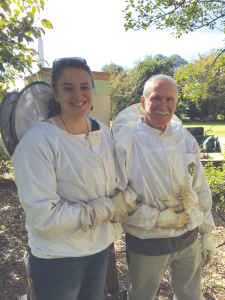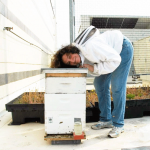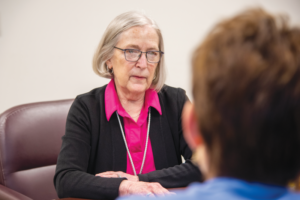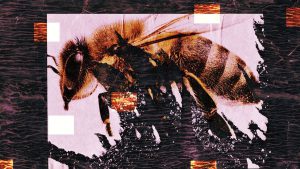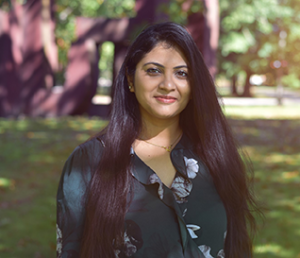By: Toni Burnham
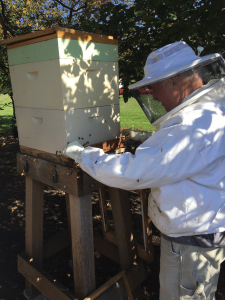 What if you were a second-year beekeeper, working for an outfit that was looking to go green, and your boss’ boss heard you were a beekeeper? And invited you to bring in a beehive to their site in a major urban area? No pressure there, right?
What if you were a second-year beekeeper, working for an outfit that was looking to go green, and your boss’ boss heard you were a beekeeper? And invited you to bring in a beehive to their site in a major urban area? No pressure there, right?
Well, what if that beekeeper was Charlie Brandts, a careful, considerate, and meticulous professional carpenter with decades of experience in the highly disciplined, tightly scheduled environment of the White House in Washington, DC, visited by tens of thousands of people from all walks of life, every year. Well, then your boss would have made a great choice.
This interview with Charlie Brandts, probably the public’s best known beekeeper today, took a look to the past and into the (very promising future) on the eve of a presidential election, which will have taken place by the time you read this. Some of you may have wondered how things have changed, and how they have grown since March 2009, when the first beehive on White House property was placed on the South Lawn and introduced to the public. Whatever you think about politics (and by now, how many of us want to think about that anymore?) this is a positive and inspiring story for all of us, and a great guy who, I promise you, you wish you knew yourself.
“When I first heard from Sam Kass (the White House chef who worked with Mrs. Obama to set up the Kitchen Garden), this was just something I was asked to do at work: I did not stress too much about it. But over the next few weeks and months, a lot of attention and questions suddenly came, and that’s when the nerves set in.” The White House had had some concerns about how to manage a colony full of bees on a stretch of grass where helicopters regularly land, a Portuguese Water Dog plays daily, and thousands of kids at a time roll Easter Eggs and attend picnics: not to mention a crazy hive stand (in my opinion) that he would have to access by standing on sawhorses.
This new job within a job required precise, just about error-free beekeeping, and coordination with everything from the National Park Service gardeners, the Secret Service, and the Office of Communications. Charlie is a quiet, soft-spoken man whose professional life had not included public speaking and working with the press. He was not sure he was prepared to take this on. He is the perfect guy for this job, however.
Charlie remembers going home after work in the first year, overthinking every choice and worrying about every event to come. “But you know, in the long run that is not sustainable. Bees are bees, and I will do the best I can, but everyone has to understand and learn and that is part of the experience.” He got more comfortable with the public and with the media, and that was an important gift to the beekeeping community at large, since this was the first time most of them had ever thought about the importance of bees and how they might live with them.
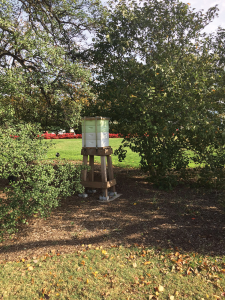 Today, Charlie is retired from full time work, and some of the chefs who helped him tend the hive have moved on. His own demands at home have changed, and he is active in mentoring members of the beekeeping community near him. Charlie is just as precise at home as he is downtown: “I want nothing to do with these bee-havers, people who just plop a hive down and call it ‘survivor stock.’ When I work with a mentee, it is usually a second- or third-year beekeeper who may have even lost a colony or two, and who has come back wanting to learn, to do better. I believe in testing and treating for mites, and I rear queens to get the health, temperament, and productivity I need from my colonies.” He says he teaches mentees, but learns as well, “After a while, the good ones start sharing what they observe with you, and how they solve problems. It is important to work with other beekeepers, who sometimes have different methods and goals. Everyone needs to keep learning.” Maybe this is why, over the years, some lucky beekeepers have had a chance to visit and interact with the White House bees, and to contribute and learn for themselves.
Today, Charlie is retired from full time work, and some of the chefs who helped him tend the hive have moved on. His own demands at home have changed, and he is active in mentoring members of the beekeeping community near him. Charlie is just as precise at home as he is downtown: “I want nothing to do with these bee-havers, people who just plop a hive down and call it ‘survivor stock.’ When I work with a mentee, it is usually a second- or third-year beekeeper who may have even lost a colony or two, and who has come back wanting to learn, to do better. I believe in testing and treating for mites, and I rear queens to get the health, temperament, and productivity I need from my colonies.” He says he teaches mentees, but learns as well, “After a while, the good ones start sharing what they observe with you, and how they solve problems. It is important to work with other beekeepers, who sometimes have different methods and goals. Everyone needs to keep learning.” Maybe this is why, over the years, some lucky beekeepers have had a chance to visit and interact with the White House bees, and to contribute and learn for themselves.
Charlie’s careful and informed methods fit right in with urban beekeeping, where concern for neighbors and the increased likelihood of mite and disease transmission make survivor stock an unreasonable choice: “How much can you ask a colony to deal with at once? We have big swings in the weather now, new pests all the time. You are responsible for your bees, and you have to pay attention to them,” says Charlie.
His methods pay off: it is not unusual for the single hive on the South Lawn to yield 200 pounds a year. This harvest has reached wounded warriors, school kids, the President’s table, the G-20, and even the Pope. “When the Make-A-Wish kids visit the Oval Office, they get some honey, too.” Hundreds of school kids who visit the garden (including the children of White House staff on “Bring Your Kids to Work Day”), as well as participants in the Easter Egg Roll, have received information on bees and beekeeping, as well as the clear personal message that bees are important wherever you find people and food.
Though no longer on site as often, he has developed additional tools and approaches for managing the White House hive, some based on his apiary in Maryland. “Since I am no longer on site every day for work, I don’t have the same access to scheduling and other information about activities at the White House. It is important to open the hive when it does not interfere with the all the work that goes on there.” If there is a period where he feels he needs to monitor events, like our recent three-week spate of rain during the nectar flow, he will closely observe his colonies in the Washington suburbs for success in foraging, and risk of swarming. “I can see the general trend from home, though the White House itself is a somewhat different situation for forage and temperatures. If I think there is a swarm risk, and my access is not great, I will consider moving the colony offsite to prevent any potential bad precedents with the public.” So far, these problems have not taken place, though Charlie points out, ”White House or no, this is agriculture, and the bees call the shots. I am managing the colonies, not giving them orders.”
Charlie has also started keeping a few colonies at a nearby business, the Sofitel. This is another point of reference, much closer this time, when planning his management of the Kitchen Garden bees, and it has shown some changes in the environment, too. “It is a bit harder to start a colony downtown than it was in 2009, though I started these from nucs a bit later this year, and I did not move in a mature hive. The cold weather hung on long enough to delay the move in, and our nectar flow was just terrible due to the rain.” He has high hopes for this neighboring apiary to winter this year, however.
In the cases where the White House Honey bees have made public appearances, it has actually been a bonus for public education. Most of you may remember the April 2015 Easter Egg roll, when a bee flew by as President Obama was reading Where the Wild Things Are to a group of excited children. They started to freak, but the Leader of the Free World said, learned from the experience with bees that Charlie has provided outside his office window: “Oh no, it’s a bee. That’s OK, guys. Bees are good.” In her remarks on October 5, Mrs. Obama made special mention of the apiary, “We love our bees. But that’s been so much fun. We give the honey away to everybody. Christmas gifts, leaders’ gifts, spousal gifts. Everybody has got honey. We’ve got plenty of it.”
Some wonder what the future of the hive is with personnel changes, retirements, the election cycle. The administration will change, but recently the Kitchen Garden received a $2.5 million dollar grant from Burpee Seeds to invest and support its future. The White House considers the Apiary an integral part of the Garden, completing the message about where food comes from and the importance of eating healthily. While the Obamas may move on, the Kitchen Garden can be a part of a tradition of other permanent plantings on the site, including the Children’s Garden established by Lady Bird Johnson in 1968, and the Rose Garden started by Edith Wilson in 1913.
In her remarks at the dedication of the Kitchen Garden on October 5, Mrs. Obama said, “I am hopeful that future first families will cherish this garden like we have.” The Clinton campaign states that the Garden will stay, the Trump campaign had not commented by interview time.
One of the questions beekeepers from around the world have asked over and over is” “How do you close up the hive when circumstances require it?” Because they certainly do! Charlie explains, “The bees do not fly free during the Egg Roll: it is just too hard to keep kids out of the flight path, and they group in front of the entrance out of curiosity.” As a carpenter and a true-blue gadget guy, he has come up with an easy device for quickly closing the front door, designed for use by any of the staff if necessary. Mostly, his helper is Susie Morrison, the pastry chef. (See Box)
Charlie also designed and placed a special ventilation box on the hive during the first few years (you may have spotted it in some of the older photos), aware that there would be times when the bees would be closed in, and wanting to make sure that they would not overheat. “I have had hives overheat at home, and I have lost them. I know what it sounds like, and I know what it smells like, so I have set up the hives and planned my management to ensure that the bees have ventilation and water. I use screened bottom boards and internal waterers, and I watch the temperatures to make sure that I get all the bees in before closing up, and that they get all the airflow that they need.”
Over the years, Charlie has had many unique and even funny experiences around beekeeping on the South Lawn. The President had a basketball court installed early in his first term, and he asked Charlie, “Now, are those bees going to bother us while we are playing?” And Charlie said, “No sir, I don’t believe that they are interested in politics.” But frankly, like most staff, the White House folks talk mostly about their commitment to work, its rewards, and their hopes for the future, if they mention where they work at all.
There is so much promise for the years ahead, with Charlie on board. “I think that the apiary will continue for the foreseeable future, and I want to stay a part of that.” Years of informed experience and solid connection to good advice and helping hands help guarantee that. He has become a shining example to beekeepers everywhere during his eight years on the South Lawn, and we are lucky to have him carefully, self-effacingly, so ably showing so many of us the way.
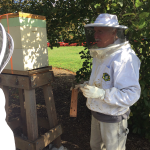 When you absolutely, positively need it closed – and anyone has to be able to do it.
When you absolutely, positively need it closed – and anyone has to be able to do it.
Charlie often closes the White House hive for densely attended events, but he’s less often onsite now. So, he had to come up with a closing board that fits snugly over the front entrance and is held in place by two bolts, secured with wing nuts, that anyone with a veil can place the night before festivities occur.
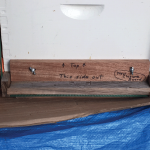 The bolts are driven into the front of the bottom box: they are machine screws with wood screws on one end, threaded bolts on the other. To drive them in, Charlie screws two nuts tightly together on the bolt end (“The nuts push together and stay inplace while I screw the bolts into the wood: you can use a plyers or vise grips to do this. If you try to use plyers directly on the threads, you make it more difficult for the person closing the hive to get the wing nuts on.”)
The bolts are driven into the front of the bottom box: they are machine screws with wood screws on one end, threaded bolts on the other. To drive them in, Charlie screws two nuts tightly together on the bolt end (“The nuts push together and stay inplace while I screw the bolts into the wood: you can use a plyers or vise grips to do this. If you try to use plyers directly on the threads, you make it more difficult for the person closing the hive to get the wing nuts on.”)
And, like every other gadget head, he has plans to improve the closing board in the future.
Toni Burnham keeps her bees and helps educate and mentor local beekeepers in the DC area.
Find me online!





